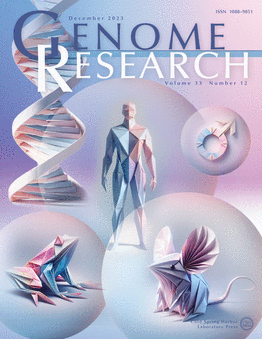CGC1, a new reference genome for Caenorhabditis elegans
IF 5.5
2区 生物学
Q1 BIOCHEMISTRY & MOLECULAR BIOLOGY
引用次数: 0
Abstract
The original 100.3 Mb reference genome for Caenorhabditis elegans, generated from the wild-type laboratory strain N2, has been crucial for analysis of C. elegans since 1998 and has been considered complete since 2005. Unexpectedly, this long-standing reference was shown to be incomplete in 2019 by a genome assembly from the N2-derived strain VC2010. Moreover, genetically divergent versions of N2 have arisen over decades of research and hindered reproducibility of C. elegans genetics and genomics. Here we provide a 106.4 Mb gap-free, telomere-to-telomere genome assembly of C. elegans, generated from CGC1, an isogenic derivative of the N2 strain. We use improved long-read sequencing and manual assembly of 43 recalcitrant genomic regions to overcome deficiencies of prior N2 and VC2010 assemblies and to assemble tandem repeat loci, including a 772 kb sequence for the 45S rRNA genes. Although many differences from earlier assemblies come from repeat regions, unique additions to the genome are also found. Of 19,972 protein-coding genes in the N2 assembly, 19,790 (99.1%) encode products that are unchanged in the CGC1 assembly. The CGC1 assembly also may encode 183 new protein-coding and 163 new ncRNA genes. CGC1 thus provides both a completely defined reference genome and corresponding isogenic wild-type strain for C. elegans, allowing unique opportunities for model and systems biology.秀丽隐杆线虫新的参考基因组CGC1
从野生型实验室菌株N2中获得的原始秀丽隐杆线虫参考基因组(100.3 Mb)自1998年以来一直对秀丽隐杆线虫的分析至关重要,自2005年以来被认为是完整的。出乎意料的是,2019年,来自n2衍生菌株VC2010的基因组组装表明,这一长期存在的参考文献是不完整的。此外,在过去几十年的研究中出现了N2基因的不同版本,这阻碍了秀丽隐杆线虫遗传学和基因组学的可重复性。在这里,我们提供了一个106.4 Mb无间隙,端粒到端粒的秀丽隐杆线虫基因组组装,由CGC1产生,N2菌株的等基因衍生物。我们使用改进的长读测序和43个顽固性基因组区域的人工组装来克服先前N2和VC2010组装的缺陷,并组装串联重复位点,包括45S rRNA基因的772 kb序列。虽然与早期组装的许多差异来自重复区域,但也发现了基因组的独特添加。在N2组装中的19,972个蛋白质编码基因中,19,790个(99.1%)编码的产物在CGC1组装中不变。CGC1组装还可能编码183个新的蛋白质编码基因和163个新的ncRNA基因。因此,CGC1为秀丽隐杆线虫提供了一个完全定义的参考基因组和相应的等基因野生型菌株,为模型和系统生物学提供了独特的机会。
本文章由计算机程序翻译,如有差异,请以英文原文为准。
求助全文
约1分钟内获得全文
求助全文
来源期刊

Genome research
生物-生化与分子生物学
CiteScore
12.40
自引率
1.40%
发文量
140
审稿时长
6 months
期刊介绍:
Launched in 1995, Genome Research is an international, continuously published, peer-reviewed journal that focuses on research that provides novel insights into the genome biology of all organisms, including advances in genomic medicine.
Among the topics considered by the journal are genome structure and function, comparative genomics, molecular evolution, genome-scale quantitative and population genetics, proteomics, epigenomics, and systems biology. The journal also features exciting gene discoveries and reports of cutting-edge computational biology and high-throughput methodologies.
New data in these areas are published as research papers, or methods and resource reports that provide novel information on technologies or tools that will be of interest to a broad readership. Complete data sets are presented electronically on the journal''s web site where appropriate. The journal also provides Reviews, Perspectives, and Insight/Outlook articles, which present commentary on the latest advances published both here and elsewhere, placing such progress in its broader biological context.
 求助内容:
求助内容: 应助结果提醒方式:
应助结果提醒方式:


